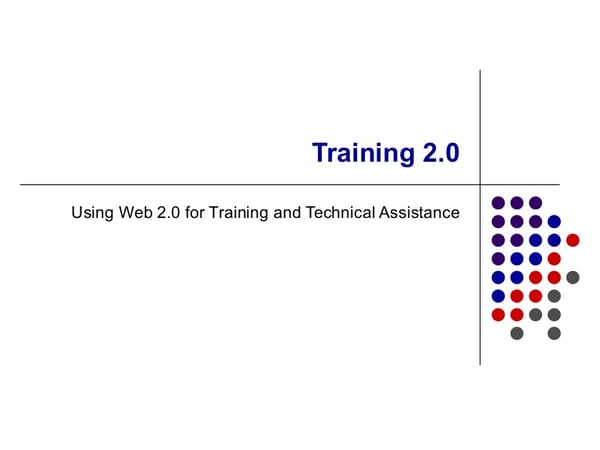1. Training in the Web 2.0 Era
The collaborative environment provided by Web 2.0 has reconfigured modern communication and education

If you dread leading employee training sessions, chances are your trainees share that lack of enthusiasm, making it much harder to transfer knowledge than it needs to be. One way to remedy this common problem is to make sure that the trainer-whether it's you or someone you select-is enthusiastic and knowledgeable.
Peter Riggs is vice-president for The Pita Pit, a quick-service sandwich chain with 180 stores across the country. Every month, new or existing franchisees assemble in Coeur d'Alene, Idaho, for several days of training. Riggs wanted to make sure they not only look forward to the training but share their experiences after it's completed. When he decided to hire a full-time trainer, he looked outside the industry and found Jane Hammons, a local math teacher with 19 years of experience and a reputation for keeping her classes engaged. Hammons had no experience in the restaurant business but had everything Riggs was looking for. "Anyone can learn systems, but if you don't have someone who is truly passionate about transferring that knowledge to eager minds, your training is going to be subpar," Riggs told me.
Dan Carroll, a vice-president at Wente Vineyards, the oldest continuously operated family-owned winery in the U.S., recently invited me to attend a three-hour training workshop he offered his staff. Here are three strategies he uses that can help you create a more engaging training experience in your own shop.
Make a connection early. Carroll makes it a point to learn attendees' names and some information about them ahead of the session. He arrives early, greets everyone by name, and establishes some familiarity. This shows the attendees that he cares about them. This makes for a better chance that they'll care about him and the information he's imparting. When he starts the training he opens with a question such as: "When is the last time you had a remarkable training experience?" This gets the discussion going and signals that the audience can expect a conversation, not another boring lecture.
Embrace multimedia. Some training experts discourage using PowerPoint. That's nonsense. PowerPoint is the most common tool to transfer knowledge. Carroll points out that it must be used in an engaging way. Carroll's PowerPoint deck had few if any bullet points. The slides were mostly photos and video clips. Carroll selected video that resonated with the twentysomethings who made up the majority of the staff and which always related back to the theme.
For example, Carroll discussed a concept he had learned from watching more than 200 concerts at the resort. He calls it "Bang, Build, Bang" and applied it to customer service: Give guests a wonderful welcome, build the relationship, and end the conversation with a memorable experience (such as offering them a discount coupon on their next visit). Rather than simply showing a PowerPoint slide with text, however, Carroll shows a concert clip to drive the point. Remember that "multimedia" means just that-different forms of media. It's not "singularmedia."
Make the experience interactive. Nobody wants to sit through a three-hour lecture. They want to participate in a discussion. Some members of Carroll's staff with whom I spoke after he trained them said he had provided a lot of content without lecturing. How so? One way was to introduce pop quizzes; Carroll would ask questions about something they had learned and turn to the group for answers. He also opened the stage to encourage attendees to share their experiences.
Role-playing provides another way to make trainings interactive. "When people are involved in skill practices like role playing, it's easier for them to apply the lessons in the real world," said Dennis Kravetz, a training consultant who applies psychological principles to workplace training. "Let's assume you want to make a person a more competent golfer. You could bring them in to a classroom and lecture to them or have them take a test online. Would that person be a better golfer? Not likely. On the other hand, if you put a club in their hands and provide feedback, there is great potential that the person will improve." Kravetz says most people agree with this approach to teach golf, but very few apply it to management or staff training. In the case of customer service training, two people could play the roles of an employee and a guest while the trainer plays the role of the instructor, offering feedback.
Creating a staff training workshop that is engaging and valuable need not be difficult. However, it does take work, some creative thinking and, above all, the attitude that you are going to make it fun for yourself and your staff. If it's fun, your staff will retain more information and tell others about the good experience. You can't ask for more.
To continue reading this article you must be a Bloomberg Professional Service Subscriber.
Read this article on the TerminalRequest a demo to learn more
If you believe that you may have received this message in error please let us know.
Ch. 7 Section 2: Multimedia for Lifelong Learning ►